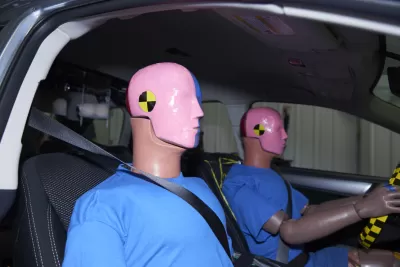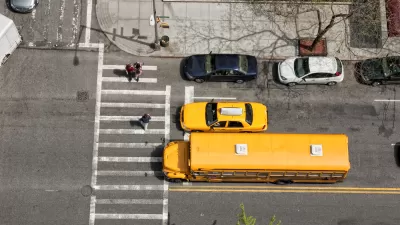New U.S. vehicle safety ratings will indicate how well driver-assistance tech and pedestrian detection mechanisms.

Starting in 2026, U.S. vehicle safety ratings will include information on driver-assistance technologies and pedestrian protection mechanisms, reports Tom Krisher for the Associated Press.
The safety ratings currently in place, which were introduced in 1978, are based on crash tests that measure the effects of crashes on passengers inside the car. Now, ratings will also include “pedestrian automatic emergency braking, lane-keeping assist, blind spot warning, and intervention if a driver tries to move toward a vehicle in a blind spot.”
The added features will receive a pass or fail grade before the system is expanded to more nuanced ratings. U.S. Transportation Secretary Pete Buttigieg says the hope is that carmakers will use these ratings to compete for customers in the same way they do with crash test ratings.
The new rules also tighten regulations around existing safety features such as automatic emergency braking and set design standards for pedestrian safety.
FULL STORY: US to add features such as blind spot warnings and pedestrian detection to vehicle crash ratings

Planetizen Federal Action Tracker
A weekly monitor of how Trump’s orders and actions are impacting planners and planning in America.

Maui's Vacation Rental Debate Turns Ugly
Verbal attacks, misinformation campaigns and fistfights plague a high-stakes debate to convert thousands of vacation rentals into long-term housing.

Restaurant Patios Were a Pandemic Win — Why Were They so Hard to Keep?
Social distancing requirements and changes in travel patterns prompted cities to pilot new uses for street and sidewalk space. Then it got complicated.

In California Battle of Housing vs. Environment, Housing Just Won
A new state law significantly limits the power of CEQA, an environmental review law that served as a powerful tool for blocking new development.

Boulder Eliminates Parking Minimums Citywide
Officials estimate the cost of building a single underground parking space at up to $100,000.

Orange County, Florida Adopts Largest US “Sprawl Repair” Code
The ‘Orange Code’ seeks to rectify decades of sprawl-inducing, car-oriented development.
Urban Design for Planners 1: Software Tools
This six-course series explores essential urban design concepts using open source software and equips planners with the tools they need to participate fully in the urban design process.
Planning for Universal Design
Learn the tools for implementing Universal Design in planning regulations.
Heyer Gruel & Associates PA
JM Goldson LLC
Custer County Colorado
City of Camden Redevelopment Agency
City of Astoria
Transportation Research & Education Center (TREC) at Portland State University
Jefferson Parish Government
Camden Redevelopment Agency
City of Claremont





























